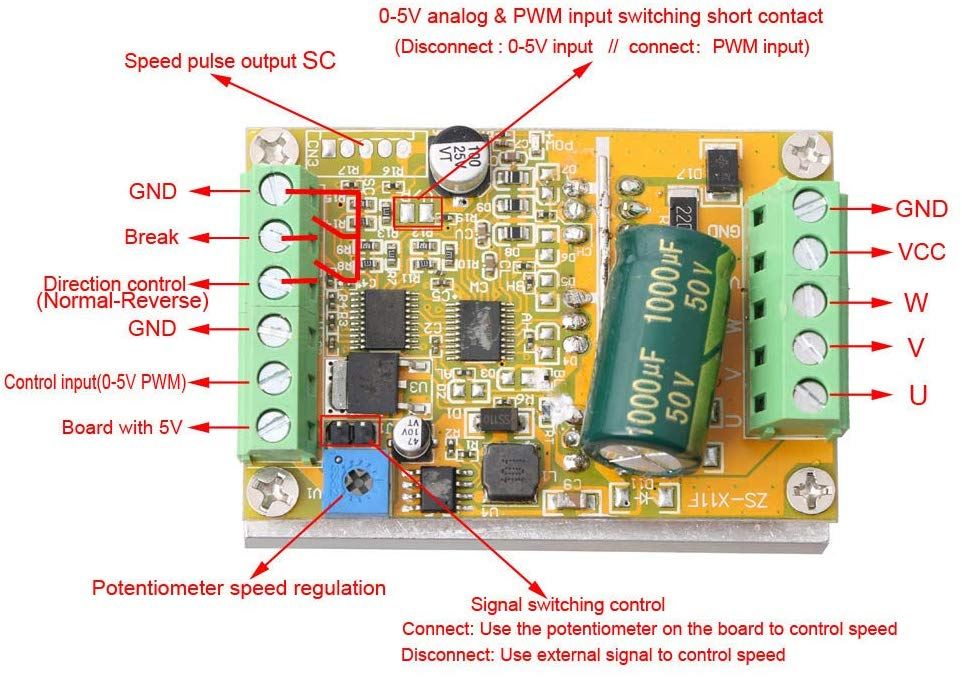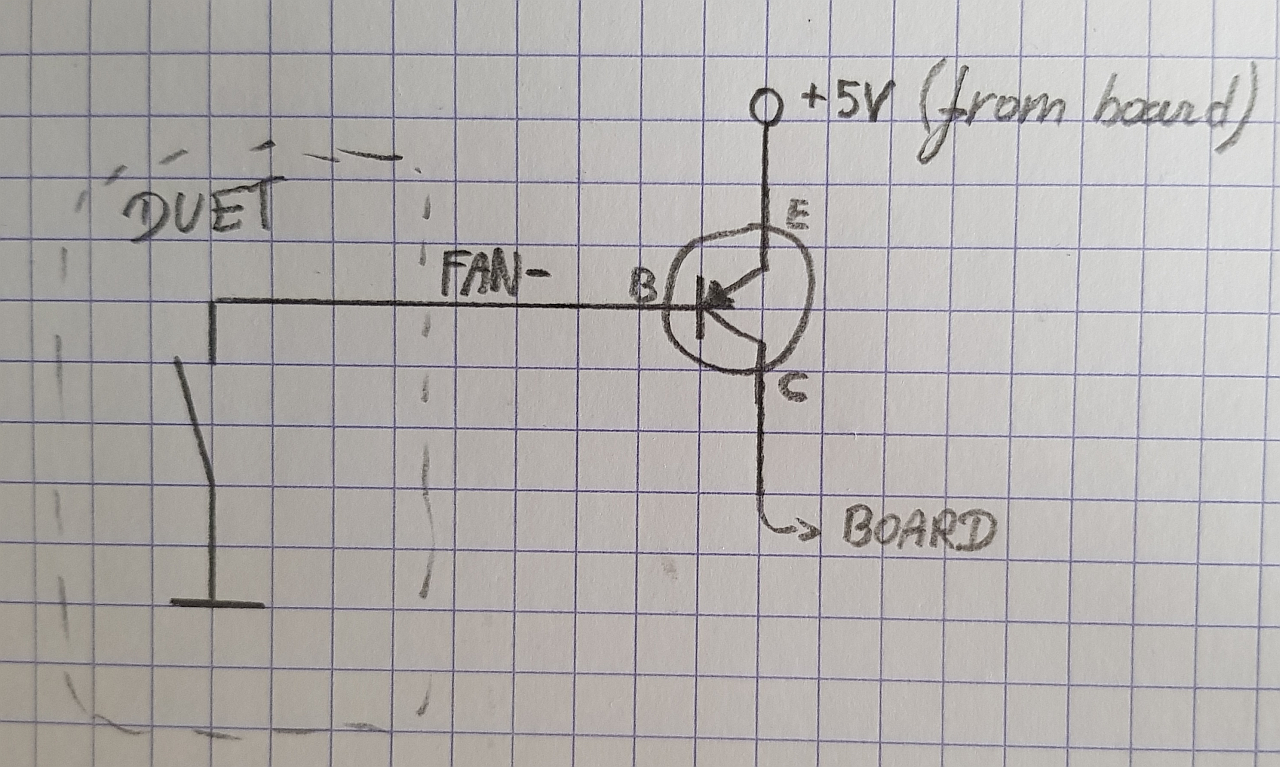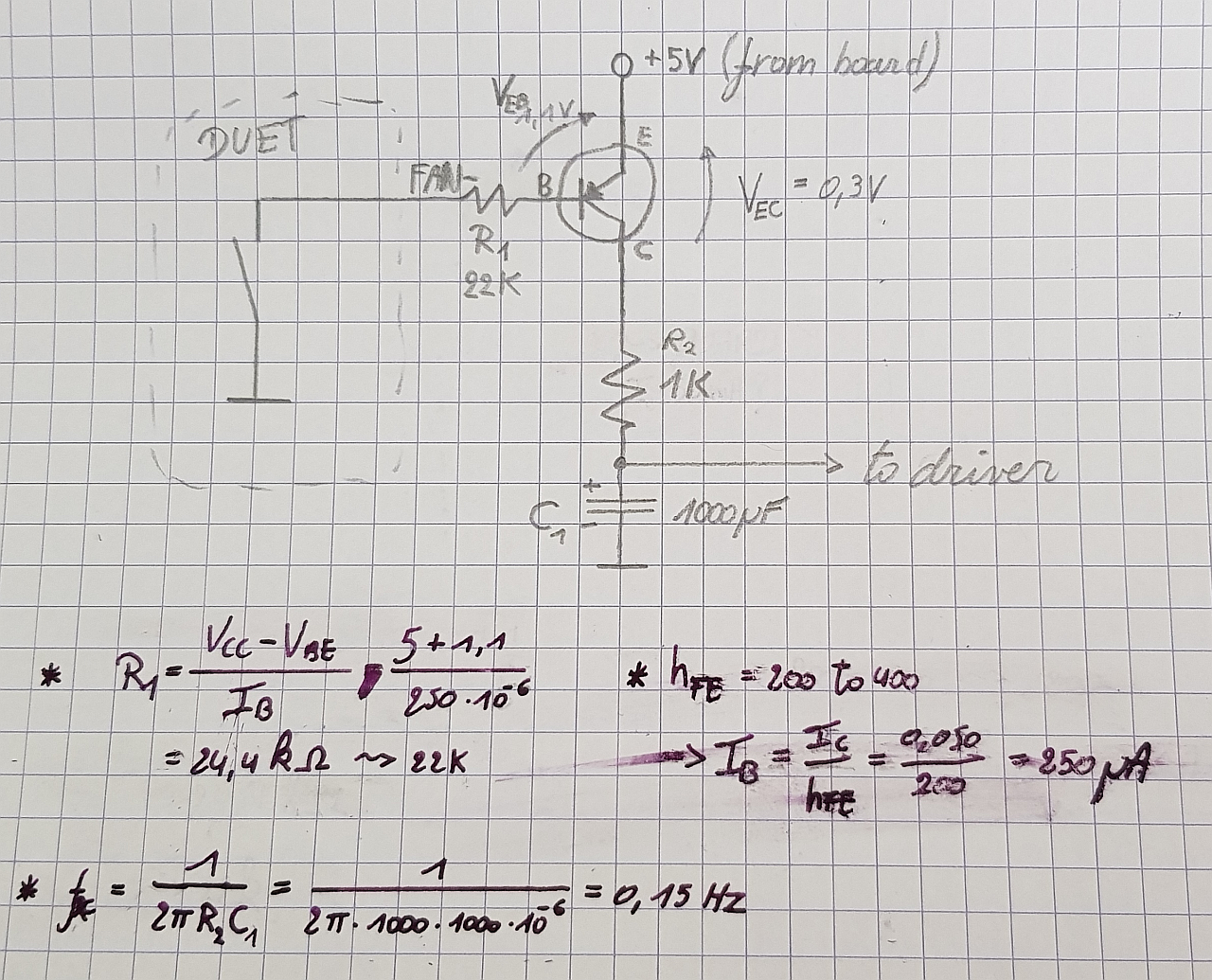Fan: switched GND to switched positive
-
My main PSU is 24V for the heaters and motors. From that, I wired a stepdown converter to 12V to V_fan, unsurprisingly powering my 12V fans. I recently went the route of incorporating a hdd motor for a part cooling fan.
To drive the motor I got myself a cheap BLDC driver board from Amazon. To control the speed I wired the control input to a Duet fan output which promptly made the driver release its magic smoke. This finally gets me to my question can I get a 5V PWM output from the Duet in my case. I was thinking a simple resistive divider from a fan output as there is no real current requirement. Any input on this?

-
Those BLDC drivers from China don't usually come with a lot of info or specs, so you have to experiment a little before you commit to a full-on voltage test, as you have discovered. I think that in PWM input mode, the speed range for the motor is from zero to some maximum value set by the pot on the BLDC driver board.
I would set the board up with the motor and power supply and then experiment a little with the voltage at the PWM input. Also check the voltage levels at the Duet board fan connector- set the fan port to maximum speed and read the voltage and then set it to minimum speed and read it again.
If the Duet is switching between 0 and 12V, a resistive divider should be OK to drop the voltage to a safe range for the PWM input on the BLDC driver. The BLDC driver might be looking for a positive input while the Duet may switch ground which could invert the speed that you get from the motor- i.e. when the Duet is trying to turn the fan off, it may be running full tilt because of the BLDC driver board. I think you can invert the PWM output in the Duet in that case.
-
might worth noting that the low side switched fan won't be quite 0v when enabled, but with the low current for a control signal the voltage drop should hopefully be insignificant.
-
@mrehorstdmd and @bearer
Yeah info, let alone a datasheet is not something that you get with these kind of products hehe. I should have assumed it's 5V for the pwm as well though. I play around with a couple of resistors and see what I get. -
The problem has evolved from converting voltage levels to something else, so I have updated the thread title as well.
The BLDC driver board that I am using has multiple GND pins, and seem internally connected. The main GND pin (next to Vcc) is directly connected to my main PSU's negative terminal. When the 2nd ground and 5V signal is connected to the logic signal side of the board, it basically just adds a permanent 5V source. Normally the Duet would switch the fan output's GND pin, but that has no use in this case.
Any ideas on how to convert a negative switched signal and convert it to positive switched?
-
@Nxt-1
I have an ideas why not hijack the fan mosfet conector and conect it to external mosfet board useing M106 I1 to invert the fan signal or take a look at M950 command there an option to invert siginal
and you can do any thing with the signal bare in mind that the logic will be 3.3 volt you can use opto coupler to convet logic -
Hi,
What is the idea behind using HDD motors?
I use 12 VDC 40x40x20 mm blowers on the normal Duet fan outputs and they work just fine.
Thanks.
Frederick
-
@Nxt-1 said in Fan: switched GND to switched positive:
Any ideas on how to convert a negative switched signal and convert it to positive switched?
You'd essentially need to throw a pnp bjt or p-channel mosfet in to do high side switching.
this might give you some insight if you sift out all the irrelevant bits
https://www.baldengineer.com/pwm-3-pin-pc-fan-arduino.html -
@fcwilt said in Fan: switched GND to switched positive:
Hi,
What is the idea behind using HDD motors?
I use 12 VDC 40x40x20 mm blowers on the normal Duet fan outputs and they work just fine.
Thanks.
Frederick
Well first of all, hdd motors and abundant and cheap. Second, I was intrigued by Mark's Rehorst's design, so I decided to play around with it.
@poohzaza said in Fan: switched GND to switched positive:
@Nxt-1
I have an ideas why not hijack the fan mosfet conector and conect it to external mosfet board useing M106 I1 to invert the fan signal or take a look at M950 command there an option to invert siginal
and you can do any thing with the signal bare in mind that the logic will be 3.3 volt you can use opto coupler to convet logicNo need to attach directly to the mosfet connector I would say? I am interested in going the optocoupler way. Drive the coupler with the fan output and switch the 5V path to the driver board, maybe with somthing like a 10k resistor in series to limit current.
-
@bearer said in Fan: switched GND to switched positive:
@Nxt-1 said in Fan: switched GND to switched positive:
Any ideas on how to convert a negative switched signal and convert it to positive switched?
You'd essentially need to throw a pnp bjt or p-channel mosfet in to do high side switching.
this might give you some insight if you sift out all the irrelevant bits
https://www.baldengineer.com/pwm-3-pin-pc-fan-arduino.htmlAny specific reason why a simple optocoupler (see my above post) might not work? I have a bag of optocoupler still laying around so that would be the easy route for me

-
@Nxt-1 said in Fan: switched GND to switched positive:
Any specific reason why a simple optocoupler (see my above post) might not work? I have a bag of optocoupler still laying around so that would be the easy route for me
None other than still needing a PNP output from the optocoupler which is less common, and what output current you need.
-
@bearer said in Fan: switched GND to switched positive:
@Nxt-1 said in Fan: switched GND to switched positive:
Any specific reason why a simple optocoupler (see my above post) might not work? I have a bag of optocoupler still laying around so that would be the easy route for me
None other than still needing a PNP output from the optocoupler which is less common, and what output current you need.
Mind sketching a diagram one would wire the transistor (with or without the opto)?

-
either get an optocoupler with an internal PNP instead of the common NPN type, or the link I posted has the plenty of relevant schematics.
-
what is you opto model number
-
@poohzaza said in Fan: switched GND to switched positive:
what is you opto model number
I have a bag of these laying around and just found some old salvaged pnp's. At the moment, my plan is to use the output npn of the opto to drive the pnp transistor as high side switch. I am currently brushing up my bjt knowledge though

-
This is what I have in mind atm, I figured the opto coupler does not add a benefit. I also simplified the internal part Duet on the diagram to a simple switch. I decided it is easier to take the 5V output from the driver board instead of a resistive voltage divider from the Duet's V_fan.
I have yet to figure out what current limiting resistors need to be placed in the circuit.

-
this viedo may help you figure out current limiting resistors
https://www.youtube.com/watch?v=WRm2oUw4owE&list=PLAROrg3NQn7cyu01HpOv5BWo217XWBZu0&index=22&t=0s -
So I assumed a collector current of 50mA, which for the bjt I used, resulted in a ~22K base resistor (if I got it right
 ). This left me with a working high side switch, pulsing ~0-5V, succes! Sadly hooking the signal to the driver board did not do what I wanted it to. The motor ramped up to max speed and stayed there. My assumption is that the Duet's default 250Hz pwm frequency is not what the driver expects.
). This left me with a working high side switch, pulsing ~0-5V, succes! Sadly hooking the signal to the driver board did not do what I wanted it to. The motor ramped up to max speed and stayed there. My assumption is that the Duet's default 250Hz pwm frequency is not what the driver expects.Therefore I decided to add an aggressive low pass filter to the output and remove the driver board solder bridge (so it expects an analogue voltage 0-5V as speed control). For some unknown reason the output voltage at the cap increased to 5V at the cap charged and stayed there, no matter what pan speed I selected.
Kind of reaching end of my patience for just getting speed control working sadly


-
I should add that I tried changing the Duet fan frequency to 25kHz as well, without success.
-
@Nxt-1 said in Fan: switched GND to switched positive:
Kind of reaching end of my patience for just getting speed control working sadl
you can have a look at
1.did you jumper use external control signal
2.remove low pass fliter and conect pwm siginal then conect jumper for pwm controlcan i have a look at esc datasheet
or cheak that pwm work correctly by conect mutimeter in volt mode you shoud see variable voltage when you adjust the fan siginal